#Turbine Control System Market
Explore tagged Tumblr posts
Text
Turbine Control Systems Market Size, Share and Global Trend By Type (Gas turbine, Steam Turbine, Hydro-Turbine, Wind Turbine), By Control System (Temperature, Pressure, Flow, Speed), By End-User (Oil and Gas, Power Generation, Refrigeration, Aerospace, Marine, Automotive) and Geography Forecast till 2022-2029
0 notes
Text
Asia-Pacific Turbine Control Systems Market research, Asia-Pacific Turbine Control Systems Market analysis, Asia-Pacific Turbine Control Systems Market trends
#Asia-Pacific Turbine Control Systems Market research#Asia-Pacific Turbine Control Systems Market analysis#Asia-Pacific Turbine Control Systems Market trends
0 notes
Text
Adaptive Wind Turbine Control System Market set to hit $6.9 billion by 2035
Industry revenue for Adaptive Wind Turbine Control System is estimated to rise to $6.9 billion by 2035 from $2.8 billion of 2024. The revenue growth of market players is expected to average at 8.4% annually for the period 2024 to 2035.
Adaptive Wind Turbine Control System is critical across several key applications including energy production, maritime navigation, weather forecasting and grid operation. The report unwinds growth & revenue expansion opportunities at Adaptive Wind Turbine Control System’s Technology Type, Turbine Capacity, Application and End User including industry revenue forecast.
Industry Leadership and Competitive Landscape
The Adaptive Wind Turbine Control System market is characterized by intense competition, with a number of leading players such as Vestas Wind Systems A/S, Siemens Gamesa Renewable Energy, General Electric Company, Nordex SE, Enercon GmbH, Senvion SA, Suzlon Energy Limited, Acciona SA, Goldwind Science & Technology Co. Ltd., Ming Yang Smart Energy Group Limited, Envision Energy, Clipper Windpower and LLC..
The Adaptive Wind Turbine Control System market is projected to expand substantially, driven by growing demand for renewable energy sources and technological advancements in wind energy sector. This growth is expected to be further supported by Industry trends like Regulatory Support and Incentives for Wind Energy Adoption.
Detailed Analysis - https://datastringconsulting.com/industry-analysis/adaptive-wind-turbine-control-system-market-research-report
Moreover, the key opportunities, such as harnessing untapped markets, technological advancements paving the way and strategic collaborations to expand horizons, are anticipated to create revenue pockets in major demand hubs including U.S., Germany, China, Denmark and Spain.
Regional Shifts and Evolving Eco Systems
North America and Europe are the two most active and leading regions in the market. With challenges like high initial investment and technical complexity, Adaptive Wind Turbine Control System market’s eco system from raw material extraction / component manufacturing / system assembly to end-user is expected to evolve & expand further; and industry players will make strategic advancement in emerging markets including Brazil, South Africa and Indonesia for revenue diversification and TAM expansion.
About DataString Consulting
DataString Consulting offers a complete range of market research and business intelligence solutions for both B2C and B2B markets all under one roof. We offer bespoke market research projects designed to meet the specific strategic objectives of the business. DataString’s leadership team has more than 30 years of combined experience in Market & business research and strategy advisory across the world. DataString Consulting’s data aggregators and Industry experts monitor high growth segments within more than 15 industries on an ongoing basis.
DataString Consulting is a professional market research company which aims at providing all the market & business research solutions under one roof. Get the right insights for your goals with our unique approach to market research and precisely tailored solutions. We offer services in strategy consulting, comprehensive opportunity assessment across various sectors, and solution-oriented approaches to solve business problems.
0 notes
Text
A turbine control system is a sophisticated network of sensors, actuators, and control algorithms designed to monitor, regulate, and optimize the operation of turbines. Turbines are mechanical devices that convert the strength of a shifting fluid (such as steam, gas, or water) into mechanical work, which is usually used to generate electricity, propel vehicles, or perform a number of mechanical tasks.
0 notes
Text
Induction Generators Market Overview and Regional Outlook Study 2017 – 2032
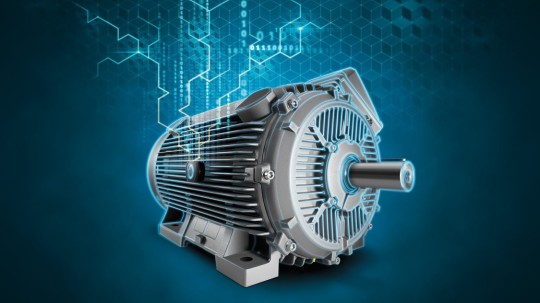
Market Overview:
The induction generators market refers to the industry involved in the production, distribution, and sales of induction generators. Induction generators are a type of electrical generator that operates based on the principle of electromagnetic induction. They are commonly used in various applications, including wind turbines, hydroelectric power plants, and standalone power systems.
Induction Generators Market is projected to be worth USD 44.8 billion by 2032, registering a CAGR of 9.50% during the forecast period (2023-2032)
Here are some key points about the induction generators market:
Growing Renewable Energy Sector: The increasing focus on renewable energy sources, such as wind and hydro power, has driven the demand for induction generators. These generators are widely used in wind turbines to convert the kinetic energy of the wind into electrical energy.
High Efficiency and Reliability: Induction generators are known for their high efficiency and reliability. They have simple construction, require minimal maintenance, and offer good performance in various operating conditions. These factors contribute to their popularity in power generation applications.
Varied Power Output Range: Induction generators are available in a wide range of power outputs, ranging from a few kilowatts to several megawatts. This flexibility makes them suitable for both small-scale and large-scale power generation projects.
Technological Advancements: Ongoing technological advancements have led to the development of more efficient and advanced induction generators. These advancements aim to enhance power generation efficiency, reduce costs, and improve overall performance.
Environmental Considerations: With increasing concerns about climate change and the need to reduce greenhouse gas emissions, the adoption of renewable energy sources like wind and hydro power is gaining momentum. Induction generators play a significant role in supporting this transition by providing clean and sustainable power generation solutions.
Government Policies and Incentives: Government initiatives, regulations, and incentives supporting renewable energy projects can significantly impact the induction generators market. Subsidies, feed-in tariffs, and tax benefits provided by governments encourage the adoption of renewable energy technologies, thereby driving the demand for induction generators.
Future Outlook: The induction generators market is expected to witness continued growth in the coming years due to the increasing demand for renewable energy and the transition towards a low-carbon economy. Technological advancements, cost reductions, and supportive government policies are likely to further boost market expansion.
We recommend referring our Stringent datalytics firm, industry publications, and websites that specialize in providing market reports. These sources often offer comprehensive analysis, market trends, growth forecasts, competitive landscape, and other valuable insights into this market.
By visiting our website or contacting us directly, you can explore the availability of specific reports related to this market. These reports often require a purchase or subscription, but we provide comprehensive and in-depth information that can be valuable for businesses, investors, and individuals interested in this market.
“Remember to look for recent reports to ensure you have the most current and relevant information.”
Click Here, To Get Free Sample Report: https://stringentdatalytics.com/sample-request/induction-generators-market/3308/
Market Segmentations:
Global Induction Generators Market: By Company • ABB • GE • Brush HMA • Techtop • Victron Energy • SycoTec • Sicme Motori • Robert Bosch • TRUMPF • VEM Group Global Induction Generators Market: By Type • High Voltage Induction Generators • Medium Voltage Induction Generators • Low Voltage Induction Generators Global Induction Generators Market: By Application • Wind Turbines • Micro Hydro Installations • Other Global Induction Generators Market: Regional Analysis All the regional segmentation has been studied based on recent and future trends, and the market is forecasted throughout the prediction period. The countries covered in the regional analysis of the Global Induction Generators market report are U.S., Canada, and Mexico in North America, Germany, France, U.K., Russia, Italy, Spain, Turkey, Netherlands, Switzerland, Belgium, and Rest of Europe in Europe, Singapore, Malaysia, Australia, Thailand, Indonesia, Philippines, China, Japan, India, South Korea, Rest of Asia-Pacific (APAC) in the Asia-Pacific (APAC), Saudi Arabia, U.A.E, South Africa, Egypt, Israel, Rest of Middle East and Africa (MEA) as a part of Middle East and Africa (MEA), and Argentina, Brazil, and Rest of South America as part of South America.
Visit Report Page for More Details: https://stringentdatalytics.com/reports/induction-generators-market/3308/
Reasons to Purchase Induction Generators Market Report:
• To obtain insights into industry trends and dynamics, including market size, growth rates, and important factors and difficulties. This study offers insightful information on these topics.
• To identify important participants and rivals: This research studies can assist companies in identifying key participants and rivals in their sector, along with their market share, business plans, and strengths and weaknesses.
• To comprehend consumer behaviour: these research studies can offer insightful information about customer behaviour, including preferences, spending patterns, and demographics.
• To assess market opportunities: These research studies can aid companies in assessing market chances, such as prospective new goods or services, fresh markets, and new trends.
• To make well-informed business decisions: These research reports give companies data-driven insights that they may use to plan their strategy, develop new products, and devise marketing and advertising plans.
In general, market research studies offer companies and organisations useful data that can aid in making decisions and maintaining competitiveness in their industry. They can offer a strong basis for decision-making, strategy formulation, and company planning.
Click Here, To Buy Premium Report: https://stringentdatalytics.com/purchase/induction-generators-market/3308/?license=single
About US:
Stringent Datalytics offers both custom and syndicated market research reports. Custom market research reports are tailored to a specific client's needs and requirements. These reports provide unique insights into a particular industry or market segment and can help businesses make informed decisions about their strategies and operations.
Syndicated market research reports, on the other hand, are pre-existing reports that are available for purchase by multiple clients. These reports are often produced on a regular basis, such as annually or quarterly, and cover a broad range of industries and market segments. Syndicated reports provide clients with insights into industry trends, market sizes, and competitive landscapes. By offering both custom and syndicated reports, Stringent Datalytics can provide clients with a range of market research solutions that can be customized to their specific needs
Contact US:
Stringent Datalytics
Contact No - +1 346 666 6655
Email Id - [email protected]
Web - https://stringentdatalytics.com/
#Certainly! Here are 30 tags for the Induction Generators Market separated by commas:#Induction Generators#Renewable Energy#Wind Power#Power Generation#Electrical Engineering#Grid Integration#Energy Efficiency#Variable Speed Technology#Power Electronics#Smart Grid#Distributed Generation#Wind Turbines#Grid Stability#Reactive Power Control#Energy Conversion#Power Systems#Generator Control#Reactive Power Compensation#Wind Farm#Voltage Regulation#Synchronous Generators#Harmonics#Reactive Power Support#Electric Power Generation#Power Quality#Wind Energy Conversion System#Stator Control#Renewable Energy Integration#Power Factor Correction
1 note
·
View note
Text
futuristic dr. neovista | the districts
------------------------------------------------------------------------------
date: may 15 2025. my final final is tomorrow in anatomy and it's my only final i should've studied for but here we are. i just realized i don't have much info on the districts....
------------------------------------------------------------------------------

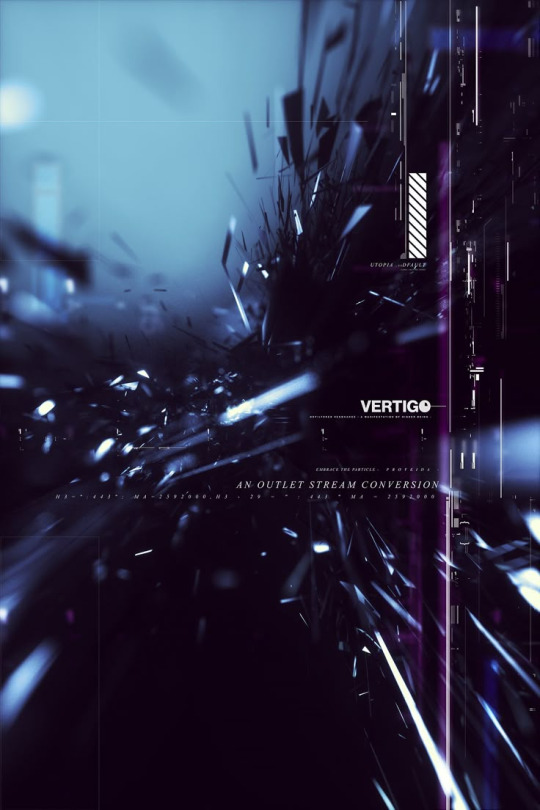
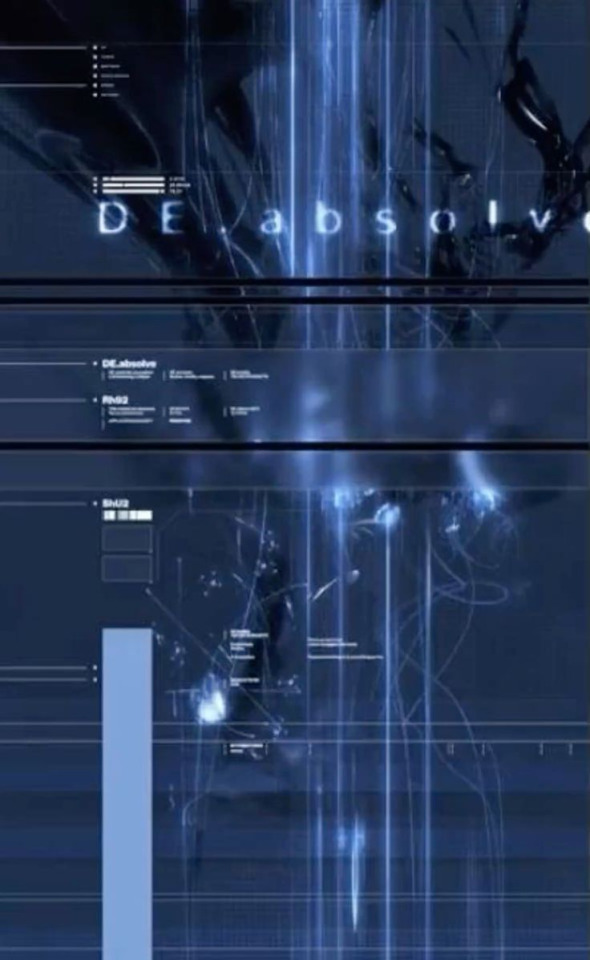


✧˖*°࿐the MIRROR district
a sleek, high-tech area with an emphasis on clean lines, reflective surfaces, and cutting-edge architecture. it’s a corporate hub where the elite and tech giants thrive. the buildings are tall, almost entirely made of glass and metal, with holographic billboards and augmented reality interfaces integrated into the environment.
დ࿐ ˗ˋ key features. ☆ 𓂃 › buildings with mirrored exteriors that reflect the cityscape, creating an almost surreal, endless horizon effect. ☆ 𓂃 › advanced public transport systems, like maglev trains and autonomous pods. ☆ 𓂃 › rooftop gardens and vertical farms to balance the starkness of the architecture. ☆ 𓂃 › strict security presence, with drones patrolling the skies and cameras on every corner. ☆ 𓂃 › neon signs and holograms are less common here, making it feel cold and sterile compared to other districts.
*ೃ༄visuals.
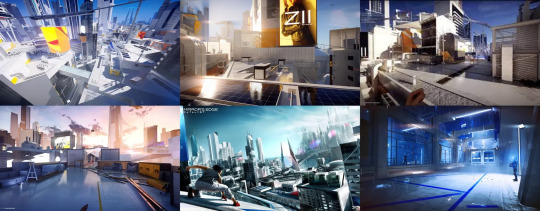
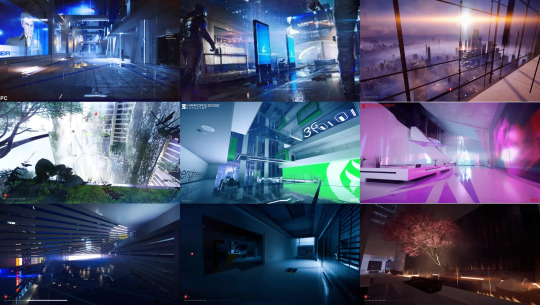


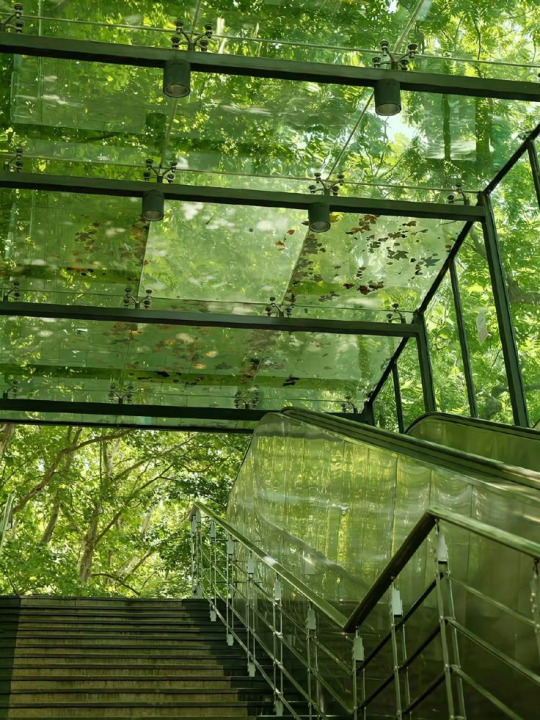


✧˖*°࿐the U district
a district dedicated to sustainability and eco-futurism. the U District is a shining example of what the city strives to achieve in balancing technology with nature. it’s bright, airy, and filled with greenery.
დ࿐ ˗ˋ key features. ☆ 𓂃 › white and gold buildings with smooth, flowing designs and integrated greenery. ☆ 𓂃 › solar panels on every building, along with wind turbines and other renewable energy sources. ☆ 𓂃 › skybridges covered in plants and flowers, connecting buildings. ☆ 𓂃 › a mix of open-air markets, small tech startups, and artisan workshops. ☆ 𓂃 › parks and water features scattered throughout, creating a tranquil atmosphere.
*ೃ༄visuals.


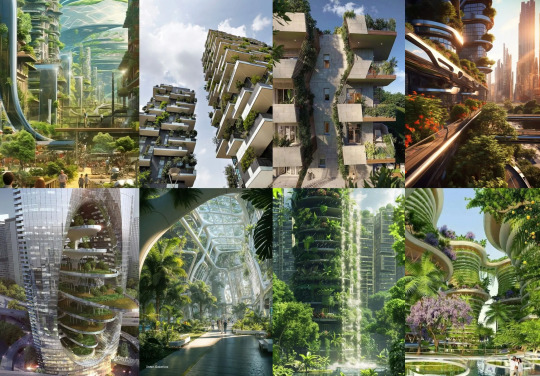






✧˖*°࿐the DREAM district
a more surreal and atmospheric area of the city, the Dream District is where creativity thrives. it’s home to artists, performers, and nightlife, but it also has an air of mystery. fog rolls through the streets, and the lights create a dreamy, otherworldly vibe.
დ࿐ ˗ˋ key features. ☆ 𓂃 › narrow streets with colorful neon signs in pink, purple, and blue, giving the district a soft glow. ☆ 𓂃 › the fog gives the district an almost ethereal quality, with lights diffusing through the mist. ☆ 𓂃 › murals and street art cover walls, blending traditional and digital art forms. ☆ 𓂃 › clubs, speakeasies, and underground venues are common, attracting a vibrant nightlife crowd. ☆ 𓂃 › hidden corners and alleyways make it an ideal place for clandestine meetings or escaping pursuit.
*ೃ༄visuals.


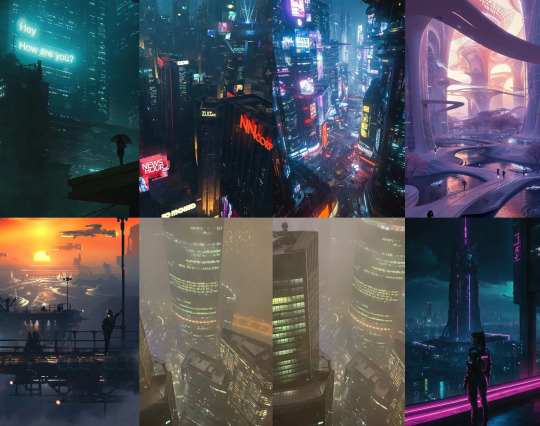




✧˖*°࿐the 127 district
the grittiest and most industrial part of the city, the 127 District is a cleaner, more controlled version of a typical cyberpunk environment. it’s the working-class heart of Neovista, where factories, workshops, and underground markets thrive.
დ࿐ ˗ˋ key features. ☆ 𓂃 › neon signs, holograms, and advertisements dominate the skyline, but the streets are more orderly than in traditional cyberpunk settings. ☆ 𓂃 › industrial facilities and tech repair shops are scattered throughout, alongside crowded markets selling everything from cybernetic parts to street food. ☆ 𓂃 › alleyways and rooftops are hotspots for street racers and vigilantes, offering plenty of cover and escape routes. ☆ 𓂃 › a mix of people from all walks of life, from workers and hackers to gang members and small-time entrepreneurs. ☆ 𓂃 › law enforcement is less present here, making it a hotspot for underground activities.
*ೃ༄visuals.


#reyaint#reality shifting#shiftblr#reality shifter#shifting#shifting community#shifting motivation#anti shifters dni#dr scrapbook#dr world#futuristic dr
9 notes
·
View notes
Text




●CEFIRO (A31) Autech version
●Overall length x overall width x overall height: 4690 x 1695 x 1375mm Wheelbase: 2670 mm ●Tread (F/R): 1460/1455mm Vehicle weight: 1400kg
Engine: RB20DET water-cooled inline 6-cylinder DOHC turbo 1998cc Maximum output:225PS/6000rpm Maximum torque: 30.0kg-m/2800rpm Suspension Front (F/R): Strut/Multilink Brake (F/R): V disc/V disc Price: 3,393,000 yen (5MT)
BUYER'S MEMO
Market price rises due to popularity of drifting
Due to the popularity of drifting and the so-called "oni camp", the used car market price for the A31 Cefiro, which has become popular as a base car with such specifications, seems to have gone up. Of these, the most popular is the twin-cam turbo sports cruising model. As far as this grade is concerned, 1.2 million yen is still a ridiculous amount. Additionally, unfortunately, there are fewer cars in normal state.
The Autech version, which is the vehicle we photographed this time, is produced in extremely low numbers, so even if you can find a good one, it will definitely be quite expensive.
PIC CAPTIONS
By adding a large turbine to the RB20DET and changing the cam and port shapes, it produces 225PS, an increase of 20PS.
The genuine leather-wrapped steering wheel that fits comfortably in your hand is made by Italvolante, Italy. This is also an equipment exclusive to Autech.
Aluminum wheels made by PIAA exclusively for the Autech version Cefiro
The size is 6JJ x 15, which is the same as the normal one.
Autech version exclusive emblems attached to the left and right sides of the front fender.
Carefully tanned Connolly leather
The seat is fully equipped with adjustment mechanisms such as dual lifters and lumbar support.
Exclusive seat and door trim made from genuine leather made by British company Connolly, which has a luxurious feel and has been used on many famous European cars and luxury cruise ships.
A trunk with a mechanism that turns into a tray and armrest when folded down. Also trunk hood
A special rear spoiler is installed.
The same rear multi-link suspension as the Silvia is made up of multiple links and ideally controls tire movement according to road conditions. The basic movements of running, turning, and stopping exhibit extremely high levels of grip.
Demonstrate your ability to move.
Early type sports touring. After MC in 1992, all cars were 2.5 liters with 3 number plates.
Since the Autech version was also slightly changed after the first MC, there are two types: an early type and a mid-term type.
MAIN TEXT TRANSLATION.
Our Standard Neo Historic Jays
Anti-high-soccer cars that bring a new sensation
Cefiro is a car that is often seen in towns and mountain passes with a strong negative camber and is considered to be a representative example of a demon-camber spec car. Nowadays, we have a strong image of such a drift machine, but when it was first announced, it had a very different impression. Under the catchphrase ``Kuneru Asobu,'' the product was sold with a strong personality and a unique coordination system that appealed to the new sensibilities of urban comfort enthusiasts. Eventually, as this new sensation wore off, another side began to attract attention. Well-made suspension with multi-link + HICAS-II, high-power engine, and FR...
Text: Yoshio Ishikawa Photography: Hiroyuki Matsuoka Vehicle cooperation: Kenichiro Takashima
A new sensation sedan introduced during the Mark II's heyday.
Today's sedans are said to be ``sluggish'' due to being pushed around by buskers and the like, but 10 years ago it was often said that sedans were enjoying the spring of the world in the mid to late 1980s. I was in a situation where I was.
Among these, the upper middle class has seen particularly rapid growth. This must have been an expression of the consciousness that all 100 million people are middle class. Under the name High Society, the popularity of the white Mark II continues to grow.
He was showing great strength.
It has a sense of class that will make you look good wherever you go, and the equipment is full of Toyota's hospitality. Armed with this feeling of ``I can feel safe with this,'' the Mark II is my father's favorite. It received a lot of support not only from users of different generations, but also from young male users who wanted to be popular with girls. No. 2 Nissan was the one most anxious about the Mark II's dominance. The R31, which debuted in 1985, shifted the Skyline, which had gained a fixed fan base due to its sports orientation, to a luxury route. We carried out major reforms.
However, this makeover ended up being a failure.
Waru. Therefore, Nissan came up with the next step, which was to create a clear model compared to the Mark II/Chaser/Cresta, which differed only in design taste.
The method was to pit three cars with different personalities against each other. The first stage of this was its debut in September 1988.
This is the first generation Cefiro that was visible. Incidentally, Nissan would later launch the Laurel in December and the R32 Skyline in May of the following year, completing the upper middle three-car alliance.
What is difficult here is the character of each car.
That's it. As for the existing models Skyline and Laurel, the former is a return to and evolution of a sports saloon, while the latter is a re-proposal of the luxury sedan model with a slightly defective essence sprinkled on it. The problem is the new model Cefiro, which is a new model whose core users are relatively young people in their early 30s.
It was positioned as a sensational sedan.
The focus is on style and packaging.
What's new about Cefiro?
Multi-link suspension adopted at the rear,
DUETIS S with integrated control of supersonic suspension and electronically controlled power steering, HICAS-II 4WS with maximum turning angle of 1 degree.
The focus is on style and packaging.
What's new about Cefiro?
Multi-link suspension adopted at the rear,
DUET-S S with integrated control of supersonic suspension and electronically controlled power steering, refinement of HICAS-II 4WS mechanism with maximum turning angle of 1 degree. There were many points of interest in terms of mechanics, such as the straight-six RB engine that achieved sharp response due to its improved performance but what stood out most of all were the styling and packaging. Although it was a sedan, its rounded design, which resembled a monoform rather than a three-box design, was innovative and seemed to be a direct commercialization of the direction Nissan had proposed at the motor show with its concept cars CUE-X and ARC-X. The basic packaging is long and low nose/short and high deck, which is typical of European cars, but what was new about Cefiro was that it didn't emphasize this too much and unified the whole car with a softer image.
Details such as projector headlamps being adopted as standard for the first time, this collection of lights, and rear combination lamps placed in continuous black garnishes on the left and right sides emphasize a new sense of style. In any case, the Cefiro had an exterior that made you think, ``Wow, this is a sedan with a shape that has never been seen before.''
Also, the grade is “Cefiro Coordination "
He developed a unique method called "coordination." All engines are 2-liter inline 6-cylinder, but cars equipped with SOHC RB20E are used for town riding, cars equipped with DOHC RB20DE are used for touring, and DOHC+ turbo RB20DET specifications are used for sports driving.
Three types are available under the name Lusing. There are two types of suspension: DUET-S S is comfort and HICAS-II is sports. Additionally, three interior styles are available: dandy, elegant, and modern, and you can choose any combination of these.
It had become a system.
9 body colors and 2 types interior
If you include the interior base colors that have been set, there are over 900 combinations, which is amazing. The Cefiro Coordination, a ready-made choice system, is said to be a great weapon for people in their 30s who are particular about comfort in their lives and are particular about food, clothing, and housing.
The production team must have calculated this.
Yosui Inoue's TV commercial ``How are you all?'' and the catchphrase ``Kuneru Asobu,'' which seems obvious but is not very clear, also helped to attract attention, and Cefiro quickly became a popular model immediately after it's appearance. The Cefiro was certainly groundbreaking at the time, offering a new design and the natural beauty of its styling as the antithesis of the upwardly mobile, high-speed car line . However, because its freshness was its selling point, there was a strong tendency for it to become a trendy product, and although at one point the three-car alliance was steadily increasing the number of units sold, it gradually became less popular.
Cefiro slows down. In 1992 in addition to widening the body with moldings and installing a 2.5L engine, minor changes were made to the the design in the direction of diluting its characteristics, and although it ended up being a car with a long lifespan of 6 years, it fell into a rather obscure state in its final years.
The second generation, which appeared in 1994, was integrated with the Maxima and transformed into a full-fledged three-number FF saloon.
Although it lacks the strong individuality and new proposals of the first generation, it continues to exist today as a popular model that maintains the basics.
However, the interesting thing about the first-generation Cefiro is that in recent years it has suddenly come into the spotlight as a handling machine for the mountain passers. Touring manual transmissions, which were an overwhelming minority at the time, fetched unusually high prices, and people finally replaced ATs with manual transmissions.
It even created a movement to convert. The most important factor behind its popularity is the affordable price of a used car, but I think that behind its popularity is the freshness and youthfulness that the original Cefiro still has.
It is analyzed that the effect is small.
A sporty saloon where you can seriously enjoy FR
Now, it's been a long time since I've faced Cefiro.
faced. Secretly “oni campaign”
I was scared that someone would come.
However, the test car was the Autech version that was released in January 1990. This is a special Cefiro based on the sports cruising model of RB20DET+HICAS-II, which has a +20PS power increase using a ball bearing turbo, harder suspension, full aero parts, and a Connolly leather seat.
The price is nearly 800,000 yen higher than the normal model, which is why the initial monthly sales target was 30 of them, so how rare is this model?
I know it's Del.
I have no recollection of test driving this Autech version when it was new, so this will be my first experience. Compared to normal sports cruising, the engine power is clearly superior, and although it seems that the effective boost rises at a slightly higher rpm, it is truly powerful from around 350O rpm to the rev limit of 7500 rpm. This time it was an AT specification, and this one is also set to take advantage of the engine's characteristics to pull the car to its limit. As you might expect, the shift shock is quite large, and if you drive like this all the time, the load on the AT will be considerable.
I'm worried that this will happen, but anyway...
The speed of a modern 2-liter sports sedan
There is no big difference when compared to.
As a high power FR with great driving abilityit is quite stable. So that's why you can attack to the fullest.
Drift machine with demon camp specifications
This image may make the Cefiro seem frivolous, but the true nature of this car is that it is a sporty FR saloon that was built with great seriousness. Therefore, I seriously want to master the movement of FR without making any strange modifications.
This is the perfect machine for those who
want do this.
Tester Yoshio Ishikawa
When the era name changed from the Showa era to the Heisei era, a boom in self-restraint began, led by the line "How are you?" in a Cefiro commercial. The role of Yosui is played by Yoshio, who looks good in sunglasses. the female driver next door
Ichi is a rock-paper-scissors girl who is rumored on the street.
17 notes
·
View notes
Text
Right-to-buy council houses without specifically only releasing housing that already had a replacement built was of the most notable ways of the *many* that Thatcher et al screwed the UK.
I’d love to have a law put in place that landlords either have to sign contracts to provide housing under council house-type contracts with rent controls to people on housing benefit etc, or sell to the local council at compulsory purchase prices.
Same for all the houses not being lived in - use to house people under contractual controls, or have to sell to the council housing central fund.
Personally I’d start converting all the office units that are no longer needed because so many people are working remotely now into housing too.
Same for the huge city centre shops - I’m not sure if the pattern repeats elsewhere, but I live near Glasgow and the city centre has basically died since Covid. No one is renting the huge retail stores and the place is full of unhoused folk, which is a fucking scandal. So convert them into housing; let the buildings see use, and let those folks get off the streets. Pets and kids specifically allowed too - get families out of one-room shelters and into proper homes of their own.
I’ve heard that there would be issues putting in water infrastructure, but given the place is literally crumbling already and usage in so many areas is so low that having workers digging up the streets to install water lines wouldn’t cause enormous disruption, the time to do this is *now*. Build rainwater catchment and purification systems on roofs too - we get so much rain in the UK it’s kind of ridiculous not to use it! Some of that could go directly to drip irrigation in gardens, but plenty could go right into the houses/flats too. And of course this would provide tons of jobs in construction, architecture, planning etc etc.
Install gardens and green spaces around the place while you are doing this - offer some at low rent, or to buy cheaply, to market gardeners, but specifically put spaces in for communal gardens with the idea of offering allotments and encouraging people to grow their own food.
Put solar panels on every roof and integrate spaces for smaller wind turbines amongst the houses too. Huge storage batteries in basements to make the new blocks as low-footprint and self-sufficient as possible power-wise.
It would be a *fantastic* opportunity to create genuinely accessible housing - office buildings and shops already have lifts and wide corridors ideal for wheelchairs and other mobility devices, so keep that in the design when creating housing. There is a hidden epidemic of houselessness amongst disabled people and older folk with mobility needs, so create low-rent council housing that specifically fits those needs there.
It would regenerate the areas - all the smaller shopfronts not suitable for housing conversion would fill up with people offering the things people in residential neighbourhoods need, with a guaranteed payer base. People on low incomes *use* all of their incomes on necessities, so small businesses selling those necessities will do well. Offer small businesses low rents to provide those necessities. Any that don’t fill up, offer to charities and use for council staff offering the aid and advice people transitioning into housing actually *need*.
Carers are generally low-paid - so this would be an opportunity to offer them cheap housing close to a huge client base in the new accessible housing. No need for low-paid, mostly-female workers to dash constantly between clients in cars. They could walk to work and walk in between clients, who would also no longer be trapped in inaccessible homes, so people who are not actually bedbound would hopefully be less housebound.
Put rooms in the blocks for communal and co-op activities to reduce isolation - with the lifts and wide corridors, even people who are functionally housebound are likely to be able to make it to a room in their own building, and even quite young children could get to those places safely on their own if their parents are working. Wraparound childcare, paid and informal, near where folks actually live.
City centre areas that are now largely dead other than unhoused people, with limited and decreasing zero economic activity taking place and a decreasing incentive for businesses to set up there rather than in out-of-town retail parks people need to drive to, would become vibrant communities with every incentive for businesses to set up there, particularly for the small businesses that still employ the majority of people.
It wouldn’t take a lot to extend this model to transform those out-of-town business parks that are currently largely empty either; nothing says the businesses that are still there would need to move, and they would have a huge new pool of potential employees living within easily walkable distance, though there would need to be oversight to make sure places like Amazon didn’t attempt to buy them up and turn them into company housing. There would need to be a little more investment to provide green transport links like electric buses and trains so that it would be easier for small businesses to move in to provide services, but given the tax income that would result and the reduction in pollution the investment would probably pay itself back within a decade or so.
#a queer crip grows#housing#housing crisis#solarpunk#solutions#solutions to climate crisis#walkable communities#walkable cities#urban gardening#urban food growing#providing housing#ending homelessness#climate friendly#climate crisis#the future is accessible#accessibility#accessible cities#accessible communities
83 notes
·
View notes
Text
Sustainable Farming Practices: A Pathway to Future Food Security

In the face of growing global challenges such as climate change, population growth, and depleting natural resources, the need for sustainable farming practices has never been more critical. Agriculture remains the backbone of many economies, but traditional farming methods often contribute to environmental degradation, loss of biodiversity, and soil erosion. To secure the future of food production, sustainable farming offers a transformative solution that balances productivity with environmental stewardship.
1. The Importance of Soil Health
Healthy soil is the foundation of sustainable farming. Through techniques such as crop rotation, cover cropping, and reduced tillage, farmers can improve soil structure, enhance its ability to retain water, and reduce erosion. The integration of organic matter into the soil also promotes the growth of beneficial microorganisms, contributing to long-term soil fertility.
2. Water Management: Reducing Waste and Preserving Resources
Effective water management is crucial for sustainable agriculture. Traditional irrigation methods often lead to water waste, but sustainable practices like drip irrigation, rainwater harvesting, and the use of drought-resistant crops can significantly reduce water usage. Precision agriculture technologies, such as soil moisture sensors, allow farmers to optimize water application, ensuring crops receive only what they need, when they need it.
3. Biodiversity: Enhancing Ecosystem Resilience
Biodiversity plays a key role in maintaining healthy ecosystems and improving the resilience of farming systems. By incorporating diverse crops and livestock, farmers can reduce the risk of pest outbreaks and diseases. Agroforestry, which integrates trees into farming systems, enhances biodiversity while providing additional income streams, such as timber and fruit production.
4. Reducing Chemical Dependency
Sustainable farming promotes the reduction of synthetic pesticides and fertilizers, which can harm the environment and human health. Alternatives like integrated pest management (IPM) use biological control methods, such as beneficial insects, to manage pests. Additionally, organic farming methods focus on natural soil amendments and composting to enrich the land without harmful chemicals.
5. Renewable Energy in Agriculture
The shift to renewable energy sources is becoming an essential aspect of sustainable farming. Solar panels, wind turbines, and bioenergy can power farming operations, reducing reliance on fossil fuels and lowering greenhouse gas emissions. Many farms are now integrating renewable energy technologies to achieve self-sufficiency while also contributing to environmental conservation.
6. The Role of Technology in Sustainable Farming
Advances in agricultural technology are playing a transformative role in sustainability efforts. Precision farming tools, such as GPS-guided tractors, drones for crop monitoring, and automated irrigation systems, help farmers optimize inputs and maximize efficiency. These innovations not only increase productivity but also minimize waste and environmental impact.
7. Promoting Local and Organic Markets
Sustainable farming goes hand in hand with the promotion of local and organic food markets. Supporting local farmers reduces the carbon footprint associated with food transportation and encourages the consumption of fresh, seasonal produce. Additionally, organic farming practices prioritize animal welfare, soil health, and chemical-free food production, contributing to a healthier food system.
Conclusion
Sustainable farming practices offer a viable solution to the challenges facing modern agriculture. By prioritizing soil health, efficient water use, biodiversity, and renewable energy, farmers can produce food in a way that safeguards the environment for future generations. The integration of technology further enhances the potential for sustainable farming to meet global food demands while reducing the ecological footprint of agriculture. The adoption of these practices is not just a necessity for the future of farming—it is a pathway to long-term food security and environmental sustainability.
3 notes
·
View notes
Text
Exploring the Latest Breakthroughs in Technology
Introduction
Technology is evolving at a rapid pace, bringing with it groundbreaking innovations that are reshaping our world. From artificial intelligence to renewable energy solutions, these advancements are enhancing our lives in ways we never imagined. In this article, we'll explore some of the most exciting recent breakthroughs in technology that are set to transform various industries and everyday life.
1. Artificial Intelligence and Machine Learning
Artificial Intelligence (AI) and Machine Learning (ML) are at the forefront of technological innovation. AI and ML are being integrated into a myriad of applications, from healthcare diagnostics to personalized marketing. These technologies analyze vast amounts of data to make predictions, automate processes, and provide valuable insights.
AI in Healthcare
AI is revolutionizing healthcare by improving diagnostic accuracy and patient care. Machine learning algorithms can analyze medical images to detect diseases like cancer at early stages, enabling timely treatment and better patient outcomes.
AI in Everyday Life
In our daily lives, AI powers virtual assistants like Siri and Alexa, enhances customer service through chat-bots, and personalizes our online shopping experiences. The continuous improvement of AI algorithms is making these applications smarter and more efficient.
2. Quantum Computing
Quantum Computing promises to solve problems that are currently insurmountable for classical computers. By leveraging the principles of quantum mechanics, quantum computers perform complex calculations at unprecedented speeds.
Advancements in Cryptography
Quantum computing has the potential to revolutionize cryptography by breaking encryption codes that secure our digital communications. This breakthrough necessitates the development of new cryptographic methods to protect sensitive information.
Applications in Drug Discovery
In the pharmaceutical industry, quantum computing can simulate molecular interactions at a granular level, accelerating the drug discovery process and leading to the development of new, effective medications.
3. Renewable Energy Technologies
The shift towards renewable energy technologies is crucial in combating climate change. Innovations in solar, wind, and battery technologies are making renewable energy more efficient and accessible.
Solar and Wind Energy
Recent advancements in solar panel efficiency and wind turbine design are increasing the amount of energy harvested from natural sources. These improvements are making renewable energy a viable alternative to fossil fuels.
Energy Storage Solutions
Enhanced battery technologies are crucial for storing renewable energy, ensuring a consistent power supply even when the sun isn't shining or the wind isn't blowing. Breakthroughs in battery capacity and lifespan are driving the adoption of renewable energy systems.
4. Internet of Things (IoT)
The Internet of Things (IoT) connects devices and systems, enabling them to communicate and share data. This connectivity is transforming homes, industries, and cities into smarter, more efficient environments.
Smart Homes
IoT technology is making homes smarter by automating lighting, heating, and security systems. Smart home devices can be controlled remotely, offering convenience and energy savings.
Industrial IoT
In industrial settings, IoT devices monitor equipment health and optimize manufacturing processes. Predictive maintenance enabled by IoT sensors can reduce downtime and improve efficiency.
5. Blockchain Technology
Blockchain is revolutionizing how we handle transactions and data security. This decentralized ledger technology ensures transparency and security in various applications.
Financial Transactions
Blockchain is streamlining financial transactions by eliminating the need for intermediaries. It provides a secure and transparent way to transfer funds and verify transactions.
Supply Chain Management
In supply chains, blockchain offers traceability and transparency, reducing fraud and ensuring the authenticity of products. This technology is particularly beneficial in industries like pharmaceuticals and food.
6. 5G Technology
The roll-out of 5G technology is set to enhance connectivity with faster speeds and lower latency. This advancement will support the growth of IoT, autonomous vehicles, and smart cities.
Enhanced Mobile Connectivity
5G technology promises to improve mobile experiences with seamless streaming and quick downloads. It will also enable new applications in virtual and augmented reality.
Smart Cities
5G will facilitate the development of smart cities, where real-time data exchange enhances urban management systems, traffic control, and emergency services.
7. Autonomous Vehicles
Autonomous vehicles are set to transform transportation. Advances in AI and sensor technology are bringing self-driving cars closer to reality, offering safer and more efficient travel options.
Safety and Efficiency
Autonomous vehicles can reduce accidents caused by human error and optimize traffic flow, reducing congestion and emissions. They hold the potential to revolutionize the logistics and delivery sectors.
Delivery Services
Self-driving delivery vehicles and drones are making logistics faster and more reliable. These innovations are particularly beneficial in urban areas, where they can reduce traffic and pollution.
8. Biotechnology
Biotechnology is advancing rapidly, offering solutions in healthcare, agriculture, and environmental management. Innovations in gene editing, synthetic biology, and bio-engineering are opening new possibilities.
Gene Editing
CRISPR technology is enabling precise gene editing, offering potential cures for genetic diseases and innovations in agriculture. This technology is paving the way for new treatments and sustainable farming practices.
Synthetic Biology
Synthetic biology is creating new biological systems and organisms, leading to advancements in medicine, bio-fuels, and sustainable materials. This field holds promise for addressing global challenges such as disease and climate change.
9. Augmented Reality (AR) and Virtual Reality (VR)
AR and VR technologies are providing immersive experiences in entertainment, education, and various professional fields. These technologies are creating new ways to interact with digital content.
Gaming and Entertainment
AR and VR are enhancing gaming experiences by creating immersive environments and interactive game-play. These technologies are also being used in movies and virtual concerts, offering new forms of entertainment.
Professional Training
In education and professional training, AR and VR offer realistic simulations for hands-on learning. Fields like medicine, engineering, and aviation benefit from these technologies by providing safe and effective training environments.
Conclusion
The latest breakthroughs in technology are driving significant changes across various sectors. From AI and quantum computing to renewable energy and autonomous vehicles, these innovations are shaping the future and improving our lives. Staying informed about these developments is crucial for individuals and businesses alike to leverage the benefits of these technological advancements. As we look to the future, these game-changing technologies will continue to evolve, offering new opportunities and solutions to the challenges we face.
#technology#artificial intelligence#virtual reality#immersive technology#renewableenergy#ai algorithm#valuable insights#internet of things#technological advancements
2 notes
·
View notes
Text
A wind energy plant with the capacity to supply one million homes came into operation in Bahia, Brazil
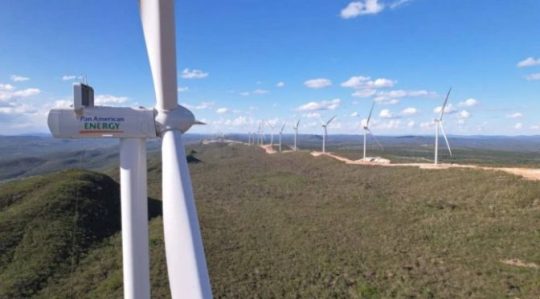
The Novo Horizonte Wind Power Complex (BA), the first project in Brazil of Pan American Energy (PAE), a global energy company, entered commercial operation. Energy production began in three of the ten parks that make up the project.
At the end of 2023, the company received authorization from the National Electric Energy Agency (Aneel) to carry out the tests, helping Brazil reach the 1,000 wind farm mark. This February, the three parks have already begun to operate commercially, advancing the initially planned deadline.
In the final phase of construction, with approximately 90% of the works completed, more than 77 wind turbines assembled and seven of the ten wind farms completed, the wind complex will have 423 MW of installed capacity, enough energy to supply around 1 million Brazilian homes. , figures that place it among the most important wind farms in the country. The forecast is that the works on the last three parks will be completed soon and that the entire complex will be commercially operational by mid-2024.
“We have a highly qualified team, which brought together around 2,600 professionals at the height of construction. From the conception of the project and the civil engineering stages, with the acquisition and assembly of equipment and machines, we have adopted the best market practices, including as standard state-of-the-art components, including protection and control systems, to provide clean energy and sustainable, safely for all Brazilians,” highlights Alejandro Catalano, general director of PAE in Brazil.
Continue reading.
#brazil#brazilian politics#politics#economy#environmentalism#renewables#energy#mod nise da silveira#image description in alt
3 notes
·
View notes
Text
Turbine Control Systems Market Size, Share and Global Trend By Type (Gas turbine, Steam Turbine, Hydro-Turbine, Wind Turbine), By Control System (Temperature, Pressure, Flow, Speed), By End-User (Oil and Gas, Power Generation, Refrigeration, Aerospace, Marine, Automotive) and Geography Forecast till 2022-2029
0 notes
Text
Tapuwa Dangarembizi Sustainable Solutions: The Economic Advantages of Renewable Energy for Industries
Various industries are quickly recognizing the critical importance of implementing sustainable practices and embracing renewable energy sources. This increased awareness stems from increasing concerns about the hazardous consequences of climate change and the impending depletion of fossil fuel storage. As a result, companies have become increasingly interested in alternative energy solutions that are not only environmentally friendly but also provide significant advantages for the economy. Within the scope of this blog post, we are going to look into the Tapuwa Dangarembizi - How can industries benefit from using sustainable energy sources that are renewable and do not deplete natural resources?

The basics of renewable energy systems
Renewable energy systems utilize the power of our planet's limitless, ever-renewing resources, gathering energy from the never-ending embrace of sunlight, wind, and water. The wonders of sustainable energy technologies are demonstrated by an arrangement of solar photovoltaic (PV) panels, wind turbines, hydroelectric power plants, and the earth's warm embrace by means of geothermal systems. Unlike the limited chain of fossil fuels, these inventive solutions provide us with an abundant, pristine path, breathing life into our environment while developing economic prosperity for industries that embrace sustainability with a passionate embrace.
Sustainable Energy minimizes Industry's Carbon Footprint
Renewable energy is being passionately adopted by industries due to its extraordinary capacity to reduce carbon emissions which propel us toward a greener future. Industries can successfully decrease their carbon footprint and minimize the negative effects of climate change. This transformation is in line with the global effort to tackle the dangers of global warming while accomplishing the sustainability goals established in projects such as the Paris Agreement. In addition, using renewable energy bolsters a company's reputation as a responsible environmental manager, drawing in eco-conscious customers as well as investors who value environmental sustainability.
Incorporating sustainable energy into your industry operations results in a decrease in costs
Contrary to popular belief, adopting renewable energy solutions can be economically beneficial for industries. While the initial investment in renewable energy infrastructure may seem substantial, the long-term cost savings outweigh the upfront expenses. Renewable energy sources like solar and wind are becoming increasingly cost-effective, with declining prices of solar panels and wind turbines making them more accessible for industrial applications. Additionally, once installed, these systems have minimal operating costs and provide a reliable source of energy, reducing reliance on volatile fossil fuel markets. Moreover, some regions offer financial incentives such as tax credits and subsidies for businesses that invest in renewable energy, further enhancing cost efficiency.
Diversify sources of energy and decrease reliance on imported fuels.
The dynamism and volatility of fuel prices, together with the possibility of supply disruptions, pose an enormous challenge to industries that depend on imported fuels. By embracing renewable energy's infinite possibilities, companies can overcome these challenges and usher in a new era of energy resilience. Industries can unlock the ability to produce their own power by installing on-site renewable energy systems, reducing the negative effects of external influences on fuel prices and availability. This newfound independence not only allows industries to take greater control over their energy expenditures but also strengthens their operations with an unwavering and uninterrupted energy supply, propelling productivity and sharpening their edge over competitors.
Conclusion
In an ever-changing energy surroundings, industries reliant on imported fuels face unpredictable price swings and supply uncertainty. To combat this, the wise move is to embrace renewable energy's limitless potential. Companies can be benefited from a more diverse energy mix, reducing reliance on volatile imports and increasing energy security. To read more about sustainable energy, check out the Eco-Visionary – Tapuwa Dangarembizi’s Journey Towards Sustainable Energy.
#Sustainable#Diversify#Footprint#natural resources#imported#surroundings#renewable energy#Tapuwa Dangarembizi#operations
7 notes
·
View notes
Text
Floating Wind Turbines Market to Surpass $83.4 Billion by 2034
The floating wind turbines market is undergoing a dramatic transformation as global economies race to decarbonize their energy supply. Valued at US$ 4.9 Bn in 2023, the market is poised to surge at an exceptional CAGR of 29.4% from 2024 to 2034, reaching an estimated US$ 83.4 Bn by the end of the forecast period. Driven by environmental mandates, rapid technological advances, and growing investor confidence, floating wind turbines are gaining traction as a scalable and sustainable solution to meet global energy demands.
A Turning Point in Renewable Energy
One of the key drivers behind the floating wind turbine market growth is the global push to reduce fossil fuel dependency. As countries seek to limit their carbon emissions and increase energy security, investment in renewable energy infrastructure—especially offshore wind—is accelerating. Floating wind turbines offer a solution that overcomes the depth limitations of traditional fixed-bottom offshore turbines, allowing access to high-wind areas in deeper waters.
According to the U.S. Department of Energy (DOE), offshore wind energy production rose 15% in 2023 compared to the previous year, underscoring the growing momentum in this sector.
Funding the Future: Eco-friendly Floating Wind Farms
Governments and international organizations are increasingly backing floating offshore wind projects with dedicated funding. One notable example is the Floatfarm project, launched in January 2024 by a consortium of 17 partners across eight European countries. Funded by the European Commission with nearly EUR 6 million, the project aims to minimize environmental impacts on marine ecosystems and boost public support for offshore developments.
These initiatives reflect a broader shift toward sustainable wind energy systems—not just in power generation, but also in turbine design, material sourcing, and lifecycle management.
Engineering Excellence: Types of Floating Foundations
The success of floating wind turbines largely depends on the type of floating foundation used. The three most common types are:
Improved engineering and a drop in installation costs are enabling larger turbine capacities and the deployment of floating systems in more challenging offshore environments.
Regional Landscape: Europe Takes the Lead
According to the latest market analysis, Europe held the largest market share in 2023, driven by robust public funding, policy support, and infrastructure maturity. Recent initiatives like France’s BATSO project, backed by EUR 2.9 million from ADEME, are focused on improving component replacement methods to cut costs and reduce environmental impacts.
Meanwhile, Asia Pacific is rapidly catching up. In June 2024, Norway-based Equinor received approval to conduct a feasibility study for Australia’s first floating wind development, highlighting the region’s growing interest in floating wind technologies.
Market Dynamics: Key Trends and Opportunities
Several trends are shaping the market trajectory:
Furthermore, the entry of new players is increasing competition and accelerating innovation. Startups and established manufacturers alike are striving to offer low-cost, high-efficiency floating wind solutions.
Competitive Landscape: Industry Leaders in Action
Prominent players in the floating wind turbines industry include:
These companies are investing heavily in R&D, focusing on rotor aerodynamics, advanced mooring systems, and intelligent wind farm control systems to strengthen their market positions.
In June 2024, Skyborn Renewables signed a Master Supply Agreement with Siemens Gamesa for 63 wind turbines for its 945 MW project in the German Baltic Sea. Likewise, Vattenfall and BASF inked a supply and service deal with Vestas for 15 MW turbines in Germany’s Nordlicht project.
Conclusion: Floating Wind’s High-Growth Horizon
With an expected market value of US$ 83.4 Bn by 2034, the floating wind turbines sector presents one of the most dynamic opportunities in the global renewable energy landscape. As technologies mature and investments rise, floating wind turbines are set to become a cornerstone of clean energy strategies worldwide.
Stakeholders who act decisively now—by investing in innovation, forging partnerships, and scaling operations—stand to lead in what is shaping up to be a transformative decade for offshore wind energy.
0 notes
Text
The global turbine control system market is experiencing growth due to several factors such as growing demand from the steam turbine industry where steam turbines are used in various industrial applications beyond power generation. Industries such as petrochemicals, paper and pulp, sugar, and more use steam turbines for processes like driving compressors, pumps, and other machinery. Control systems help maintain the desired operating conditions.
0 notes
Text
Laser Ablation Surface Cleaning Equipment Market : Size, Trends, and Growth Analysis 2032
In modern manufacturing and conservation industries, precision, efficiency, and sustainability are no longer optional—they are imperative. This shift has driven the increasing adoption of laser-based cleaning solutions. At the forefront is the Laser Ablation Surface Cleaning Equipment Market, which offers a cutting-edge alternative to traditional surface cleaning techniques.
Laser ablation is a high-precision, non-contact process that removes unwanted layers—such as paint, rust, grease, oxides, and other contaminants—from various surfaces using a concentrated beam of light. Unlike chemical or abrasive cleaning methods, laser ablation avoids surface damage, produces minimal waste, and significantly reduces environmental and worker health hazards.
Market Overview
The Laser Ablation Surface Cleaning Equipment Market was valued at USD 667 million in 2024, and is forecast to grow at a CAGR of 6.5% from 2025 to 2032. This growth is largely fueled by expanding demand across sectors such as aerospace, automotive, electronics, nuclear power, shipbuilding, and even cultural heritage restoration. The push for eco-friendly and sustainable industrial processes has positioned laser ablation as a superior solution to outdated cleaning practices involving sandblasting, dry ice, or harsh solvents.
The technology's ability to offer selective material removal, automation compatibility, and low maintenance requirements makes it attractive to both manufacturers and service providers.
Market Drivers
1. Environmental Regulations and Industrial Sustainability Goals
Stringent regulations across North America, Europe, and parts of Asia regarding hazardous emissions and industrial waste disposal are forcing industries to reconsider legacy cleaning systems. Traditional methods that use chemicals, abrasives, or dry ice create secondary waste and introduce risks related to toxic exposure, surface degradation, and waste disposal.
Laser ablation, by contrast, is a dry process that leaves minimal residue, requires no chemicals, and typically needs only a ventilation system to handle vaporized particles. This makes it a preferred option for companies aiming to reduce their carbon footprint and comply with sustainability standards.
2. Growth in High-Precision Manufacturing
Industries like aerospace, defense, microelectronics, and medical device manufacturing require extremely high levels of surface cleanliness without compromising structural integrity. Laser ablation systems can remove microscopic contaminants, oxides, or coatings without altering base materials, making them ideal for cleaning sensitive components such as turbine blades, circuit boards, or surgical tools.
The rise of electric vehicles (EVs) and miniaturized electronics further demands precise cleaning techniques to prepare surfaces for welding, bonding, or coating—tasks where laser systems excel.
3. Increasing Automation and Industry 4.0 Integration
Modern manufacturing facilities are shifting toward fully automated production lines supported by robotics and smart control systems. Laser cleaning equipment is easily integrated into these setups due to its compatibility with robotic arms, CNC systems, and real-time sensors.
Advanced systems now feature computer-controlled parameters, remote operation, and AI-based algorithms that allow for adaptive cleaning—ensuring optimal performance on irregular or complex surfaces.
4. Cost Efficiency and Long-Term ROI
Though the upfront investment in laser ablation systems can be significant, the long-term cost benefits are compelling. With minimal consumables, reduced maintenance, and no recurring chemical or abrasive media costs, these systems offer substantial savings over time. Moreover, the elimination of secondary waste treatment further reduces operational costs.
For industries handling delicate, high-value components, the prevention of damage or wear during cleaning results in fewer defects and higher product yields—adding further economic incentive.
Application Segmentation
Aerospace: Removal of corrosion, paint, and coatings from aircraft components without compromising the metal substrate. Critical for MRO (Maintenance, Repair, and Overhaul) operations.
Automotive: Pre-treatment of metals for welding and bonding, rust removal, and cleaning of molds and dies. EV battery production also benefits from precision cleaning.
Electronics and Semiconductors: Ultra-precise cleaning of circuit boards, wafers, and connectors to remove oxides and contaminants at the micron level.
Cultural Heritage and Restoration: Gentle removal of pollutants, graffiti, or aging materials from sculptures, frescoes, and monuments, preserving original surfaces.
Nuclear and Energy Sector: Decontamination of radioactive surfaces in reactors, pipelines, and tools, with remote handling options ensuring operator safety.
Regional Insights
North America remains a dominant market due to its strong aerospace and defense sectors, early adoption of green technologies, and a focus on workplace safety. The U.S. is also investing heavily in EV production and infrastructure upgrades, which increases demand for precision cleaning tools.
Europe is driven by environmental regulations, heritage conservation initiatives, and industrial automation. Germany, France, and Italy are leading adopters, especially in automotive and restoration applications.
Asia-Pacific is rapidly expanding, with China, Japan, South Korea, and India investing in high-tech manufacturing and clean energy sectors. The region's strong electronics production base also fuels demand for laser cleaning systems.
Latin America, Middle East, and Africa are emerging markets where laser ablation is gaining traction in the oil & gas, mining, and infrastructure sectors as part of modernization efforts.
Key Industry Players
The Laser Ablation Surface Cleaning Equipment Market features a mix of global laser system manufacturers and niche technology developers. Key players include:
TRUMPF – A leader in industrial laser technology, TRUMPF offers robust laser cleaning solutions integrated into automated production environments, especially for metal processing and automotive applications.
Baison Laser – Specializes in compact, high-efficiency laser cleaning machines for industrial and commercial use in China and beyond.
IPG Photonics – Known for high-power fiber laser technology, IPG provides customizable laser cleaning systems that cater to complex industrial requirements.
Coherent – Offers a diverse range of laser solutions, including precision cleaning equipment for microelectronics and heritage conservation.
Laserax – Based in Canada, Laserax develops laser systems with a focus on inline cleaning, marking, and texturing solutions, particularly for the automotive and foundry industries.
Laser Photonics – A U.S.-based company offering portable and stationary laser cleaning systems for a wide range of industries, emphasizing eco-friendly and maintenance-free operation.
These companies are actively pursuing innovation in areas such as AI-guided cleaning, mobile platforms, and energy-efficient lasers to expand their reach and enhance usability.
Industry Trends
Portable and Handheld Systems: Increasing development of lightweight, mobile laser cleaning units for on-site maintenance and field service.
AI-Powered Cleaning Protocols: Intelligent systems that analyze surface conditions and adjust laser intensity and scanning patterns dynamically.
Green Manufacturing: Adoption of laser cleaning as part of sustainable production initiatives and circular economy models.
Hybrid Systems: Combining laser ablation with other cleaning or inspection tools for multifunctional capability within industrial setups.
Browse more Report:
Cold Storage Transportation Market
Cement Electrostatic Precipitator Market
BOPET Films Market
Bioprocess Analyzers Market
Autonomous Beyond Visual Line of Sight (BVLOS) Drone Market
0 notes